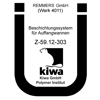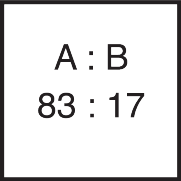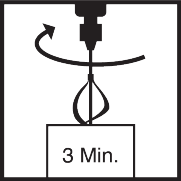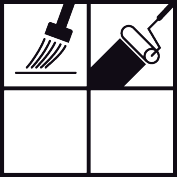Article No. 670111
Water-based transverse conducting layer

Product specifications
On delivery
Component A
Component B
Mixture
The stated values represent typical product characteristics and are not to be construed as binding product specifications.
Field of application
- Transverse conducting layer in dissipative Remmers systems
- Transverse conducting layer in the system SL Floor WHG AS (AbZ Z-59.12-303)
Properties
- Electrically conductive
- Coating compatibility test
-
Preparation
-
Substrate requirements
The substrate must be firm, dimensionally stable, capable of bearing loads and free of loose constituents, dust, oil, grease, rubber marks and other substances that could interfere with adhesion.
The adhesive pull strength of the surface after priming must be at least 1.5 N/mm² on average (smallest single value min. 1.0 N/mm²), compressive strength at least 25 N/mm².
Suitable Remmers epoxy primers, epoxy scratch coats or epoxy mortars must always be used.
-
Preparations
Before the application of the product a smooth surface must be produced, e.g. with a scratch coat.
Refer to the current Technical Data Sheet for detailed information on the single products.
Install earthing elements and copper strands prior to application, based on the size and shape of the surface. Make sure that no point on the surface is more than 10 m from an earthing point or a connected copper strand.
-
-
Preparation
-
Combination container
Add the entire quantity of the hardener (component B) to the base compound (component A).
Mix thoroughly with a slow-speed electric mixer
(approx. 300 - 400 rpm).Pour the mixture into a separate container and mix again thoroughly.
Mix for at least 3 minutes.
Insufficient mixing is indicated by streaks forming.
-
Application
-
The times given are reduced at higher temperatures and increased at lower temperatures, in particular in combination with high humidity.
-
Working tools / cleaning
-
Paintbrush, rubber scraper, epoxy roller, mixer
-
More detailed information can be found in the Remmers Tool Programme.
Clean tools, equipment and any splashed material immediately with water while still fresh.
Take suitable protective and waste disposal measures when cleaning.
-
Storage / shelf life
-
If stored unopened in its original container in a cool, dry place and protected against frost, the product will keep for at least 9 months.
-
Usage
-
Approx. 0.15 kg/m² binder (depending on the substrate)
-
-
Application examples
-
TCL
Pour the material onto the prepared surface, spread evenly using a rubber scraper, then roll crossways using a suitable epoxy roller.
min. 0.15 kg/m² binder (depending on the substrate)
-
-
General information
-
Unless otherwise specified, all of the values and application rates given above have been determined under laboratory conditions (20 °C). Slight deviations from these values may arise if the product is worked with on site.
Before the application of the covering layer, the correct functioning of the transverse conducting layer and of the connections must be proved and registered in a measurement report.
Uneven application and inadequate ventilation can lead to differences in gloss level and irregular or elevated resistance to earth.
Take the black colour of the transverse conducting layer into consideration when selecting the colour of the subsequent coating.
Further notes on working, system construction and maintenance of the listed products can be found in the latest Technical Data Sheets and the Remmers system recommendations.
For the installation of systems that are subject to approval, the directions contained in the relevant approval must be observed.
-
-
Disposal instructions
-
Larger quantities of leftover product should be disposed of in the original containers in accordance with the applicable regulations. Completely empty, clean containers should be recycled. Do not dispose of together with household waste. Do not allow to enter the sewage system. Do not empty into drains.
-
-
Safety / regulations
-
For professional users only!
For further information on the safety aspects of transporting, storing and handling the product and on disposal and environmental matters, please see the current Safety Data Sheet and the brochure entitled "Epoxy Resins in the Construction Industry and the Environment", issued by Deutsche Bauchemie e.V. (3rd edition 2022).
-















